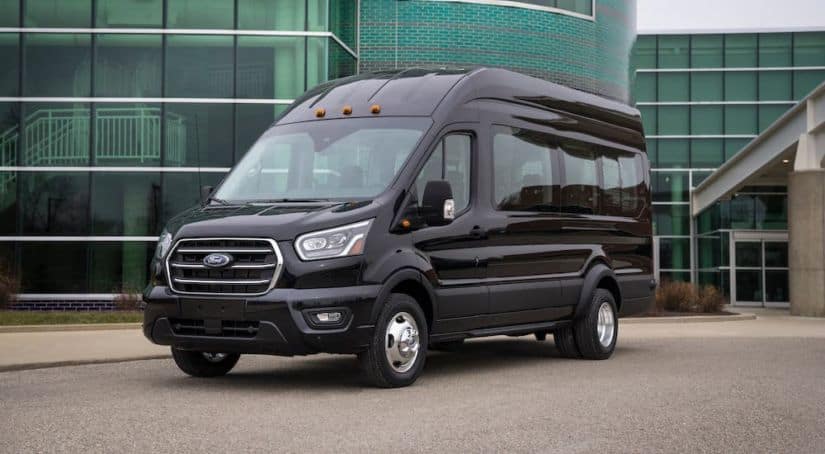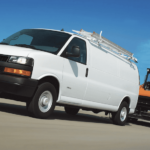The typical commercial cargo van buyer used to be a budget-minded business owner looking for a no-frills utility vehicle to transport cargo. They’d compare a couple of choices, like the 2021 Ford Transit vs 2021 Ford Transit Connect, and add a couple dozen of them to the fleet. Nowadays, it’s not uncommon for a young, twenty-something couple to wander a dealer’s lot looking to buy one for themselves, but why? What would you say if we told you they’re not actually shopping for a new vehicle; instead, they’re house hunting. Welcome to the world of van conversions.
Buyers looking to pull up roots and hit the road indefinitely are flooding dealerships in search of vans to convert into mobile living spaces. What started as an experiment by a group of young, adventure-hungry wanderers has ballooned into a lifestyle. These intrepid travelers are eschewing traditional apartment life for a more carefree alternative, and with the availability of so many remote work opportunities, mobile life has never been more possible.
If you’re in the market for a conversion van, we recommend checking out the Ford line of commercial cargo vans. The Transit and Transit Connect differ in size and capabilities, giving you a lot to choose from. You’ll want to consider how small is too small and evaluate your conversion plan to determine which van is the best fit. Since this is your future home, details matter. Let’s walk through each vehicle and better understand how they’re different.
Size and Features: The 2021 Transit

Here more than with any other automotive comparison, size is absolutely critical. In fact, it’s the number one consideration. After all, you’re going to live in this van, so understanding interior dimensions sets you up for either a comfortable living experience or future headaches (literally, as in bumping your head on the ceiling). How do the Transit and the Transit Connect compare?
For 2021, the Transit’s Gross Vehicle Weight Rating (GVWR) is increased to 11,000-lbs, which means it can handle more weight, as in stuff like sinks, portable toilets, solar panels, and cabinetry. Several roof heights (low, medium, high) and a couple of wheelbase options (regular, long, or Long-EL) allow you to fully customize the van’s dimensions. Three weight classes – the T-150, the T-350, and the T-350HD DRW allow you to dial in your GVWR.
The wheelbase is your most important exterior measurement. The Transit’s swings from a low of 130 inches to a high of 148 inches, while overall length runs from 220 inches to 264 inches. Wheelbase measures the space between the center of the front tire and the center of the rear tire, and it tells you how much interior space you’re likely to have, which is important when converting a van. Overall length is the vehicle’s bumper-to-bumper length. Pay attention to overall length because the larger it is, the more challenging it will be to maneuver in tight spaces, like campgrounds.
On the inside, cargo height dimensions range from 57 inches for the regular, low roof Transit to 81.5 inches for the Long-EL high roof. That means that if you want to be able to stand upright in the back of your van, you probably aren’t going to want something with the low roof. We recommend checking with your van conversion company before pulling the trigger on a specific trim.
Ford offers the Transit with a choice of two different powertrains: a 3.5-liter V6 engine (275 hp and 262 lb-ft of torque) or a 3.5 liter EcoBoost twin-turbo V6 engine (310 hp and 400 lb-ft of torque). Commercial vehicles aren’t required to undergo EPA testing for fuel economy, but Car and Driver estimates a 17 MPG highway rating with the turbocharged motor. You can also choose from front-wheel drive or all-wheel drive, and if you’re a true adventurer, you’ll probably want to opt for the latter.
Size and Features: The 2021 Transit Connect
The smaller Transit Connect packs a lot of useful space into its smaller profile, and with the choice of a short or long wheelbase, buyers have some wiggle room. The wheelbase options are 105 inches or 121 inches, matched with an overall length of 174 inches and 190 inches, respectively. That’s significantly smaller than the Transit, but is still plenty of space to work with for your tiny house on wheels, especially if you plan on traveling alone.
Most automotive journalists believe the Transit Connect is underpowered. The only available engine available for retail sale is a 2.0-liter four-cylinder that delivers an unexciting 162 hp and 144 lb-ft of torque. However, fleet buyers have the option of a larger 2.5-liter engine with 169 hp, so you might find one if you’re lucky. At a GVWR of between 5,130 and 5,420 lbs, you’re limited to fewer build-out materials. Think very minimalist, lightweight options. The Transit Connect is essentially a delivery van, designed to navigate busy city streets and tuck into small parking spots.
Inside the Transit Connect, you will find a cargo height of 50 inches for the cargo van versions or 43 inches for the passenger van. With those dimensions, you can expect to do some crouching, or you can modify the van with a pop-up feature or roof tent for more interior space when camping. Converting the Transit Connect means making some sacrifices but gives you the advantage of lower running costs and more nimble handling.

Conversion Packages: Transit vs Transit Connect
Ford is getting in on the conversion game, giving buyers some in-house factory options to prepare the Transit for conversion. There’s a good reason, because it’s a record year for cargo van sales, aided by the camper movement, but also due to a massive spike in package delivery demand. In fact, July 2020 saw a 40-year high for RV sales with some 43,035 vehicles sold. That means Ford is focusing more time and effort on enhancing its van line.
Ford’s answer on the Transit is the Adventure Prep Package, which adds all-wheel drive, a reinforced front axle, the upgraded 3.5-liter twin-turbo motor, and a limited-slip rear differential. That latter feature helps increase traction by distributing power to the wheels in response to current road conditions and is commonly found on heavy trucks. A whole host of driver-assist safety systems – including adaptive cruise control and various parking sensors – are also included, as well as privacy glass.
All these options don’t seem to get you any closer to the van life, but they all play a vital role in preparing the Transit for conversion. Your conversion contractor can then begin the process of building out the interior, including insulation, power, heating/cooling, and plumbing. The Transit Connect isn’t offered with any factory packages, so you’ll want to work closely with your conversion builder to ensure the trim you purchase includes the structure and dimensions called for in the build-out design.
Is #vanlife for everyone? Maybe not. It is romantic and thrilling to hit the road with your home along for the ride, but your plan is also going to require a lot of practical details, like finding campgrounds or other legal spots to park and repair shops that can get you out of a bind when your solar panels fail. Finding the perfect van is only the first step. However, with a Ford Transit or Transit Connect, you can start out on the right foot with one of the most dependable and versatile vans available today.



